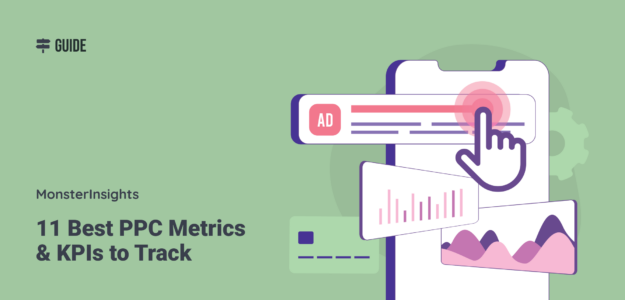Are you trying to get the most out of your advertising budget and ensure every penny counts? Tracking the right PPC metrics is key to boosting your ad performance and getting the best results for your money.
When you monitor the right numbers, you can see what’s working, what needs fixing, and how to improve your campaigns.
In this article, we’ll go through 11 essential PPC metrics and KPIs to track for your website.
The Benefits of Tracking PPC Metrics and KPIs
Tracking PPC metrics and KPIs is crucial for a successful advertising strategy. Here are the key benefits:
- Better budget management: Allocate your budget to the best-performing ads and save money.
- Improved campaign performance: Identify what’s working and adjust your marketing strategies for better results.
- Increased ROI (Return on Investment): Ensure your ad spend brings in the highest returns.
- Understanding customer behavior: Gain insights into how customers interact with your ads.
- Enhanced targeting: Refine your audience targeting to reach the right people more effectively.
- Competitor Insights: Tracking KPIs lets you see how your performance compares to competitors, helping you stay ahead in the market.
Setting and tracking PPC KPIs help you improve your campaigns, making them more efficient and successful. Next, we’ll dive into the specific PPC metrics and KPIs you should track to achieve your marketing goals.
11 Best PPC Metrics & KPIs to Track
Now that we understand why tracking PPC metrics and KPIs is so important let’s look at the specific metrics that can help you optimize your campaigns.
By focusing on these KPIs, you can make smarter decisions, improve your ad performance, and get the most out of your budget.
Here are the 11 best PPC metrics and KPIs you should be keeping an eye on:
- Conversion rate (%)
- Cost per acquisition (CPA)
- Revenue on ad spend (ROAS)
- Cost per click (CPC)
- Click-through rate (CTR)
- Impression share (%)
- Quality score
- Clicks
- Source and Conversions
- Impressions
- Average position
1. Conversion rate (%)
Conversion rate is the first and most crucial PPC metric you should monitor. It shows the percentage of users who take a desired action after clicking on your ad. This action could be purchasing, signing up for a newsletter, or filling out a contact form.
Understanding your conversion rate is important because it measures how effectively your ad turns clicks into meaningful actions.
A higher conversion rate indicates that your advertising budget is being used efficiently, leading to better overall performance and more significant returns on your investment.
To calculate your conversion rate, use the formula:
Conversion Rate = (Number of Clicks/Number of Conversions) ×100
For example, if 50 people clicked on your ad and 10 made a purchase, your conversion rate would be:
Conversion Rate = (10/50) x 100 = 20%
To measure your conversion rate effectively, start by setting clear goals in your tracking tools, such as Google Analytics or your ad platform’s dashboard.
MonsterInsights offers a simple solution for WordPress site owners with their PPC Ad Tracking Addon.
This tool eliminates the hassle of dealing with complex code; you only need to paste your Conversion ID from Google Ads into the MonsterInsights settings under Insights » Settings » Conversions.
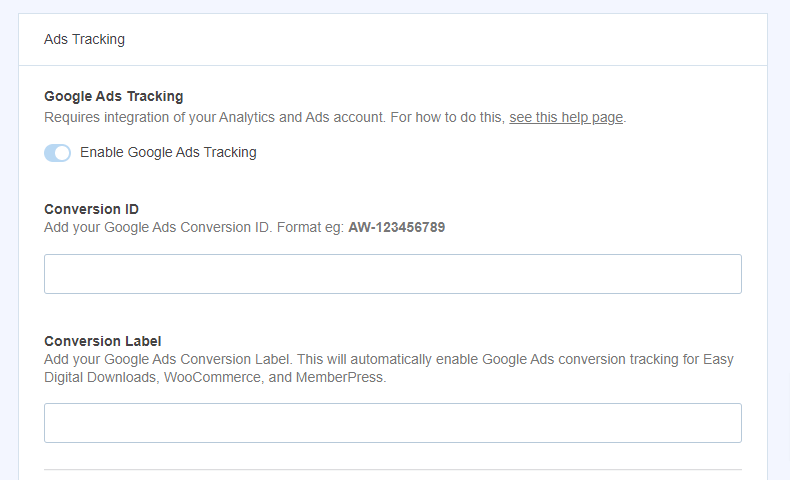
After you’ve set up PPC Ad Tracking, you’ll start tracking ad performance and seeing PPC analytics right within your WordPress dashboard.
Get started with Monsterinsights today!
If you’re using a platform different from WordPress, you can track conversions through Google Ads, Facebook Ads, or any preferred analytics tool by setting up conversion tracking codes on your website.
Read our full guide on using Google Analytics for Google Ads Conversion Tracking to learn more.
Keeping an eye on your conversion rate helps you understand what works and allows you to make smart adjustments to boost your campaign performance.
Next, let’s look at another key metric, Cost per acquisition (CPA), which is also vital for tracking PPC success.
2. Cost per acquisition (CPA)
Cost per Acquisition (CPA) is another essential PPC metric that helps you understand how much you spend to acquire a customer or lead. It’s the total cost divided by the number of conversions, giving you a clear picture of the efficiency of your ad campaigns.
CPA is important because it tells you how much you’re paying for each conversion, whether that’s a sale, a sign-up, or another action. Keeping your CPA low means you get more value for your advertising spend and maximize your ROI.
To calculate CPA, use this formula:
CPA = (Total Conversions/Total Ad Spend)
For example, if you spent $500 on ads and got 25 conversions, your CPA would be:
CPA = ($500/25) = $20 per conversion
To keep track of your CPA, start by setting up conversion tracking in your ad platforms. This involves defining what counts as a conversion (e.g., a sale, sign-up, or download) and ensuring your tracking tools are correctly configured to measure these events.
Did you know you can automatically set up tracking for various events with MonsterInsights?
MonsterInsights is the best Google Analytics plugin for WordPress, enabling you to connect your site with Google Analytics and see all the crucial data in your WordPress dashboard.
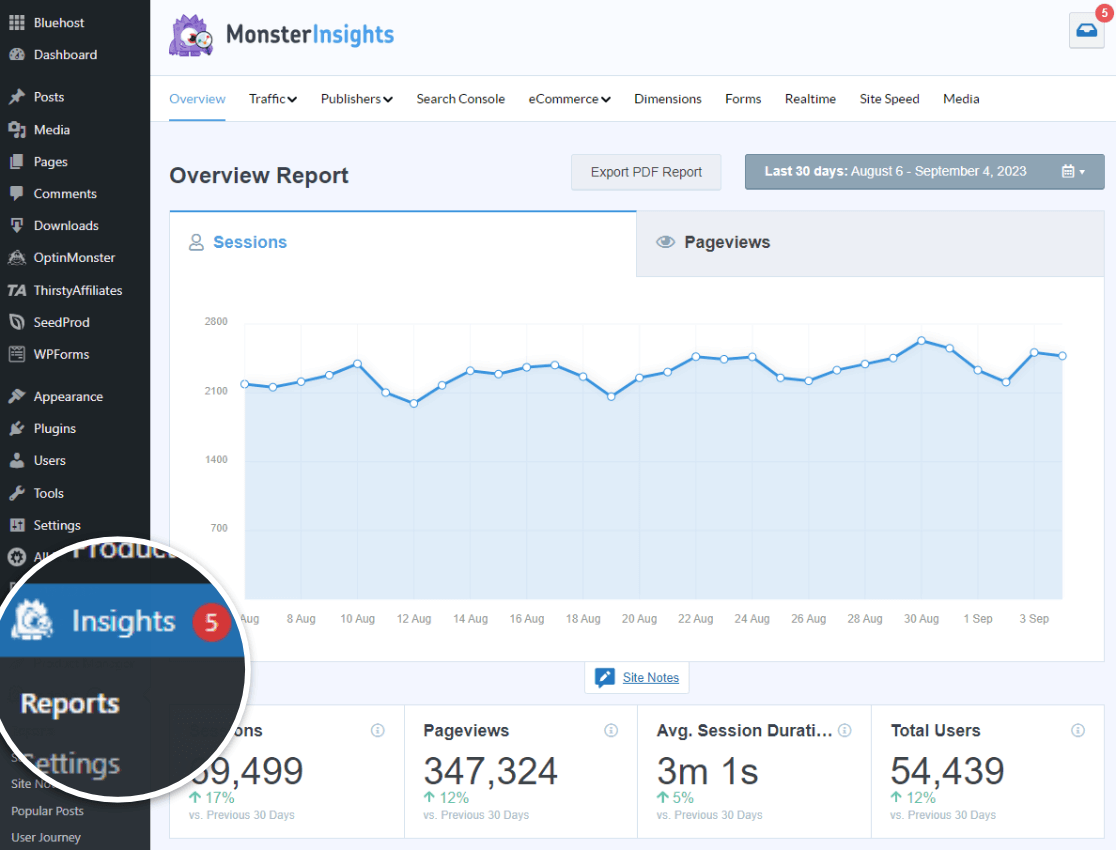
With just a couple of clicks, MonsterInsights lets you set up event tracking for a whole range of clicks and actions, including file downloads, affiliate clicks, eCommerce sales, and much more.
Read our Complete Guide to GA4 Conversion Tracking for WordPress.
For those who don’t use WordPress, you can still track conversions by setting up tracking codes from your chosen ad platform on your website. This is typically done through your analytics tool’s settings or integrations section.
By closely monitoring your CPA, you can ensure you’re spending your advertising budget wisely, allowing you to invest more in campaigns that bring the best results.
3. Revenue On Ad Spend (ROAS)
Revenue On Ad Spend (ROAS) is another PPC metric you should monitor. It measures the effectiveness of your advertising by showing how much revenue you generate for every dollar spent on ads.
It helps you understand the financial return of your campaigns and whether your advertising budget is being utilized effectively.
ROAS is important because it directly links your ad spend to the revenue it generates, clearly indicating your campaign’s profitability. A higher ROAS means your ads generate more revenue than their cost, indicating efficient and successful campaigns.
To calculate ROAS, use this formula:
ROAS = (Revenue from Ads/Cost of Ads)
For example, if you spent $1,000 on ads and earned $5,000 in revenue, your ROAS would be:
ROAS = $5,000/$1,000= $5
This means you’re earning $5 for every $1 spent on ads.
If you have an eCommerce site, set up eCommerce tracking in Google Analytics or your preferred analytics tool to accurately track sales and revenue from ads.
MonsterInsights allows WordPress users to effortlessly set up eCommerce tracking and get all the relevant stats right within WordPress. These include conversion rates, transactions, top-selling products, cart abandonment rates, average order value, and much more.

By monitoring your ROAS, you can identify which ads drive the most revenue and decide where to allocate your advertising budget for the best return.
Next, we’ll explore the Cost Per Click (CPC), an important metric that indicates how well your ads attract clicks.
4. Cost Per Click (CPC)
The average amount you spend each time someone clicks on your ad is crucial for managing your advertising budget effectively. This is called Cost Per Click (CPC).
CPC is important because it directly affects your advertising costs. Lower CPCs mean you can get more clicks for your budget, increasing your chances of driving traffic to your website and achieving your campaign goals.
To calculate CPC, use this formula:
CPC = (Total Ad Spend/Number of Clicks)
For instance, if you spent $300 on ads and received 100 clicks, your CPC would be:
CPC = ($300/100) =$3 per click
Most ad platforms like Google Ads, Facebook Ads, and Microsoft Ads provide detailed reports on your CPC. Regularly check these reports to see how much you’re paying per click.
Tracking your CPC helps you monitor your advertising expenses and ensure you get the most value for your money. It’s a key metric for optimizing your campaigns and avoiding overspending on clicks that don’t convert into meaningful actions.
Next, we’ll look at Click-Through Rate (CTR), which shows how effectively your ads attract clicks from your audience.
5. Click-Through Rate (CTR)
Click-Through Rate (CTR) measures the percentage of people who click on your ad after seeing it. It’s calculated by dividing the number of clicks by the number of impressions (the number of times your ad was shown) and multiplying by 100.
CTR is important because it indicates how engaging and relevant your ads are to your audience.
A higher CTR means more people are interested in your ad, leading to more traffic to your website and potentially more conversions.
It also helps improve your ad’s quality score on platforms like Google Ads, which can lower costs and improve your ad positioning. We’ll cover more about quality scores later.
To calculate CTR, use this formula:
CTR = (Number of Clicks/Number of Impressions) × 100
For example, if your ad was shown 1,000 times and received 50 clicks, your CTR would be:
CTR = (50/1,000) × 100 = 5%
A good CTR typically ranges from 2% to 5% for search ads and is lower for display ads and social media, around 0.5% to 3%, depending on the platform.
Monitoring your CTR helps you understand how effective your ads are at attracting attention and can guide you in making improvements to increase your campaign’s success.
High CTRs can lead to better ad placements and lower costs, making your advertising efforts more efficient and effective.
6. Impression Share (%)
Have you ever wondered how often your ads show up when people search? That’s where Impression Share (%) comes in.
It’s a key PPC metric that tells you the percentage of times your ads are displayed out of the total opportunities they had to appear.
It’s calculated by dividing the number of impressions your ads received by the total estimated number of impressions they could have gotten and multiplying by 100.
Impression Share helps you understand how well your ads perform relative to their potential reach. A high Impression Share indicates that your ads appear frequently when people search for your keywords, while a low Impression Share suggests there’s room for improvement in your campaign settings or budget.
To calculate Impression Share, use this formula:
Impression Share = (Actual Impressions/Total Eligible Impressions) × 100
For example, if your ads had 1,000 impressions and the total eligible impressions were 2,000, your Impression Share would be:
Impression Share = (1,000/2,000) × 100 = 50%
A good Impression Share is typically above 70%, meaning your ads are shown most of the time. If it’s below 50%, it suggests you need to increase your budget or improve your ad quality.
If your Impression Share is low, consider increasing your bids or budget to ensure your ads are more competitive. This can help your ads appear more frequently in relevant searches.
Read How to Optimize Google Ads: 5 Tips & Strategies to Boost Clicks to learn more about ad strategies.
By monitoring your Impression Share, you can see how effectively your ads compete in the marketplace and identify opportunities to improve your campaign visibility.
Next, we’ll dive into the Quality Score, which directly impacts your ad’s performance and cost.
7. Quality Score
Ever wondered why some ads seem to outperform others? That’s where Quality Score comes into play.
This key PPC metric assesses the relevance and usefulness of your ads, influenced by factors like keyword relevance, landing page quality, and click-through rate (CTR).
A higher Quality Score helps your ads rank better and reduces costs per click (CPC). It ensures your ads effectively meet user needs, leading to better visibility and greater ROI.
Quality Score is rated on a scale from 1 to 10, with higher scores indicating more relevant and effective ads.

You can find your Quality Score in the reporting section of ad platforms like Google Ads.
In general, you should try to keep your Quality Score high to improve performance and get the most out of your ad spending.
8. Clicks
Clicks are one of the most fundamental PPC metrics, representing the number of times users have clicked on your ads.
Tracking clicks is crucial because it directly measures the initial user engagement with your ads. The more clicks you get, the higher the chance of turning those visitors into customers or leads.
Clicks also help you assess the effectiveness of your ad copy, targeting, and overall campaign performance.
Clicks are typically recorded automatically by ad platforms like Google Ads and Facebook Ads. You can view the number of clicks your ads receive in the reports section of these platforms.
Adding UTM parameters to your URLs can help you track clicks from various campaigns in more detail, including the source, medium, and specific campaign name. This allows you to analyze traffic from different ads more effectively.
For WordPress users, MonsterInsights allows you to set up UTM parameters for any link and campaign easily. This setup lets you track your campaigns and access detailed data in the Campaign report directly from your WordPress dashboard:
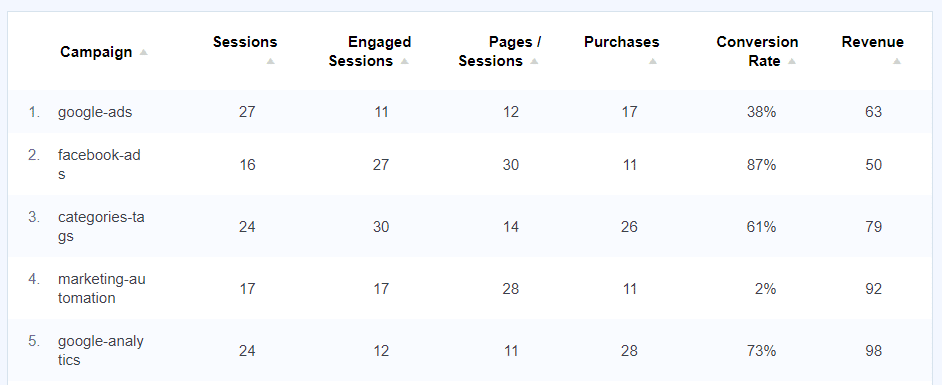
Additionally, MonsterInsights allows you to track any link click, including affiliate, eCommerce, button, outbound, and custom link clicks.
If you’re not using WordPress, you can still track clicks effectively by setting up UTM parameters in your URLs and using tools like Google Analytics to monitor the data. This helps you track how users interact with your ads and website.
Read our Beginners Guide to UTM Parameters (And How to Use Them).
By tracking clicks, you can gain valuable insights into user engagement and identify which ads and campaigns drive the most traffic to your site.
9. Source of Conversions
You want to know where your traffic comes from and how well each source converts. Tracking the Source of Conversions shows how effectively different channels, such as search engines, social media, email, and direct traffic, drive conversions.
You typically use tools like Google Analytics to measure the Source of Conversions. These tools can track the origin of your traffic and the actions users take on your site.
For WordPress users, MonsterInsights shows the top sources and how each is converting directly from the WordPress dashboard in the Source/Medium report:
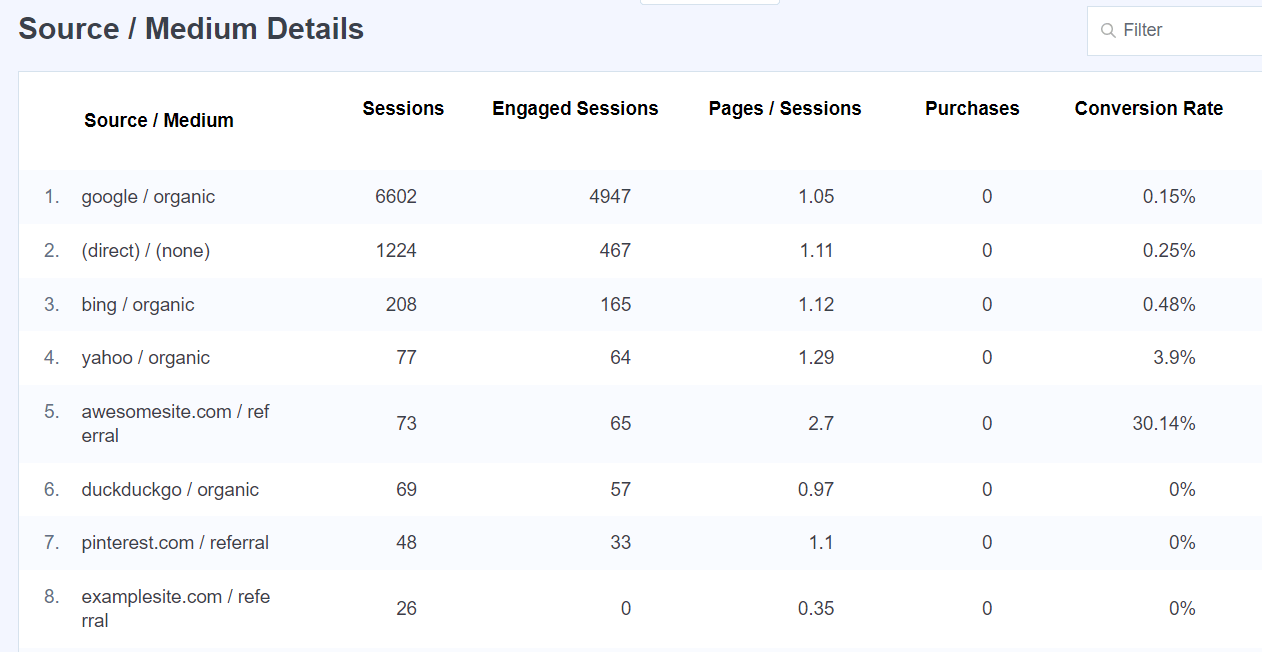
This report shows which sources bring visitors to your website, purchases, and the conversion rate.
Knowing the source of your conversions allows you to allocate your marketing budget more effectively. It helps you identify which channels deliver the best results and which may need more attention or adjustments.
10. Impressions
Impressions represent the number of times your ad is displayed to users. Every time your ad appears on a search result page or a website, it counts as an impression, regardless of whether it was clicked on.
Tracking impressions is important because it shows how often your ads are seen by potential customers.
A higher number of impressions indicates that your ad has a wide reach, increasing the chances of attracting clicks and getting more visitors to your website.
Impressions are automatically tracked by most ad platforms. You can view the total number of impressions in your campaign reports on these platforms.
Look at impressions alongside other metrics like clicks and conversions to get a complete picture of your ad’s performance. High impressions with low clicks might indicate a need to improve your ad copy or targeting.
11. Average position
Rounding off our list of crucial PPC KPIs is the Average Position.
Average Position lets you know how high up your ad appears in search results, showing you the typical rank your ad holds among competitors.
A lower number means your ad is more visible, sitting higher on the page, while a higher number indicates a lower, less visible spot.
Understanding your average position is essential because ads at the top of the page get more clicks and impressions. A good placement means higher visibility, increased traffic, and better chances of converting clicks into customers.
Ad platform reports show your average position. This metric is automatically tracked and reflects the average rank of your ad over a set period.
If your ad isn’t appearing as high as you’d like, consider raising your bids or improving your ad quality to climb the ranks.
Higher-quality ads with relevant content and well-optimized landing pages can help you achieve a better average position, often without increasing your budget.
And that’s it!
We hope you liked this article on what PPC Metrics and KPIs to track to improve your ad performance and maximize the return on your marketing investments.
Maybe you’d also like to read:
- Top 10 Google Ads Retargeting Best Practices
- How to Optimize Google Ads: 5 Tips & Strategies to Boost Clicks
- How to Find Google Ads Reports in Google Analytics (GA4)
Not a user of MonsterInsights yet? Get started today!
Remember to follow us on X, Facebook and YouTube for more free tutorials.
